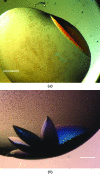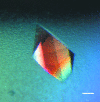Automating the application of smart materials for protein crystallization
- PMID: 25760603
- PMCID: PMC4356364
- DOI: 10.1107/S1399004714027643
Automating the application of smart materials for protein crystallization
Abstract
The fabrication and validation of the first semi-liquid nonprotein nucleating agent to be administered automatically to crystallization trials is reported. This research builds upon prior demonstration of the suitability of molecularly imprinted polymers (MIPs; known as `smart materials') for inducing protein crystal growth. Modified MIPs of altered texture suitable for high-throughput trials are demonstrated to improve crystal quality and to increase the probability of success when screening for suitable crystallization conditions. The application of these materials is simple, time-efficient and will provide a potent tool for structural biologists embarking on crystallization trials.
Keywords: molecularly imprinted polymers; protein crystallization; smart materials.
Figures





References
-
- Asanithi, P., Saridakis, E., Govada, L., Jurewicz, I., Brunner, E. W., Ponnusamy, R., Cleaver, J. A., Dalton, A. B., Chayen, N. E. & Sear, R. P. (2009). ACS Appl. Mater. Interfaces, 1, 1203–1210. - PubMed
-
- Asherie, N. (2004). Methods, 34, 266–272. - PubMed
-
- Curcio, E., Profio, G. D. & Drioli, E. (2003). J. Cryst. Growth, 247, 166–176.
Publication types
MeSH terms
Substances
LinkOut - more resources
Full Text Sources
Other Literature Sources

